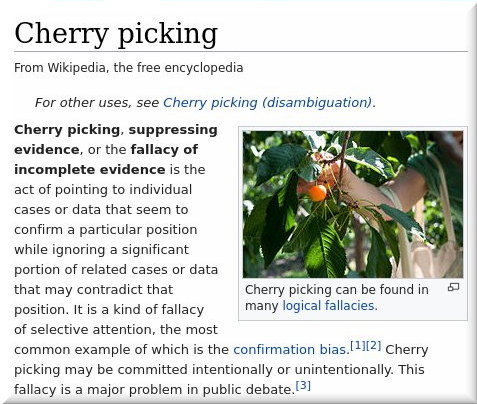

Reference: Cherry picking
"The entire system has become resistant to -- if not intolerant of -- software patents. We need to keep it that way."As one can expect, software patents proponents are nitpicking in an effort to bring software patents back. This post collates examples from the past week.
Bilski Blog, one of the loudest anti-Bilski and anti-Alice sites (the name of the blog is rather misleading), started toying around with a couple of words, cherry-picked from a recent decision. The term “well-understood" somehow became an entire long blog post and it said:
The Federal Circuit has now had enough opportunity to address Mayo’s “well-understood, routine, conventional” test that we should have a good understanding of it. We don’t (or at least I don’t).
To begin with, the Federal Circuit cases don’t seem to differentiate among these terms. The cases also universally connect the three terms with “and” rather than “or,” but curiously most of the cases don’t seem to actually require all three to be explicitly met for a determination of ineligibility. See, e.g., Content Extraction, where the Federal Circuit noted only that the patent owner had conceded one function as being “routine.” Finally, there seems to be real disagreement about the extent to which these terms address facts as opposed to legal standards. In this post, I’m not going to comprehensively analyze all these issues, but instead will focus primarily on what these common terms mean.
"It wasn't long ago that Patently-O mocked a judge and Watchtroll does this kind of thing almost every week."Charles Bieneman, a software patents proponent, mentioned Aatrix at the end of last month and then wrote about Koh's decision as follows:
A district court has granted a Rule 12 motion for judgment on the pleadings, holding that claims of two patents directed to modifying toolbars of Internet applications are patent-ineligible under the Alice test and 35 USC ۤ 101. MyMail, Ltd. v. ooVoo, LLC, Nos. 17-CV-04487-LHK and 17-CV-04488-LHK (N.D. Cal. March 16, 2018) (Judge Lucy Koh).
"What's more interesting here is that we're seeing district courts, this time in California, increasingly citing 35 USC ۤ 101 when they reject dubious patents."Not too long ago CAFC dealt with a virtual advertisement patent. James Korenchan liked this case because it stood out from the rest. Cherry-picking this fairly old decision (from last month), the anti-PTAB brigade was attempting to give the impression that 35 U.S.C. ۤ 101 is nothing for software patents proponents (trolls and lawyers) to worry about. To quote the background:
In a decision issued last month, the Patent Trial and Appeal Board reversed the final rejection of all the pending claims in U.S. Application No. 12/628,383. The claims at issue are directed to evaluating an effectiveness of an advertisement in a virtual reality universe of a multiplayer online game. In particular, the claimed invention involves evaluating whether a proximity and direction of a user's avatar enables the avatar to effectively view a virtual advertisement and, based on this evaluation, providing a virtual barrier (e.g., a virtual landscape element) that induces the avatar to navigate towards viewing the advertisement. The claims had been rejected under 35 U.S.C. ۤ 101 as reciting patent ineligible subject matter in the form of an abstract idea of organizing human activities.